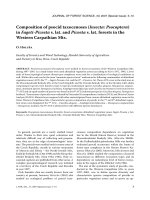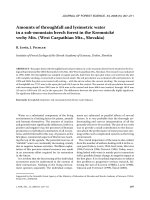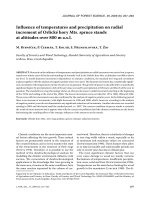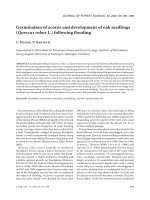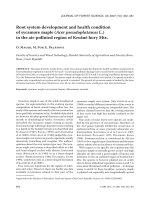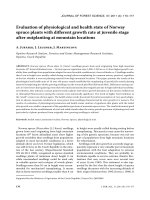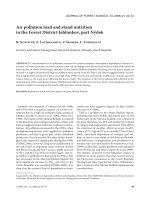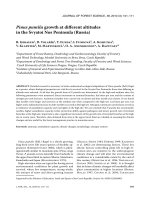Báo cáo lâm nghiệp: "Air pollution load and stand nutrition in the Forest District Jablunkov, part Nýdek" docx
Bạn đang xem bản rút gọn của tài liệu. Xem và tải ngay bản đầy đủ của tài liệu tại đây (1.22 MB, 6 trang )
J. FOR. SCI., 54, 2008 (2): 49–54 49
JOURNAL OF FOREST SCIENCE, 54, 2008 (2): 49–54
Intensive development of industry in the 1960s
and 1970s had a negative impact on forest eco
-
systems due to a high air pollution load, mainly of
sulphur dioxide (L et al. 2002; H
1990). e region of the Silesian Beskids is situated
in the direction of prevailing winds from Třinec and
Ostrava agglomeration with heavy industry concen-
tration. Air pollution decreased in the 1990s, when
desulphurizing devices were applied by pollution
producers, and also a great part of the industrial
production was decreased. e state of the atmos-
phere was improved significantly during the 1990s
(ČHMÚ 2001), however, long-term acidification in
the soil is still an important cause of forest decline
and decay. During the last 5 years, a slight increase
in NO
2
and SO
2
has been recorded again, and es-
pecially it is pollution by dust particles (PM
10
) that
has increased. In the Moravia-Silesian Region, the
most significant increase in PM
10
and NO
2
in the
Czech Republic was recorded (ČHMÚ 2006). It is
clear that the present level of deposition in forest
stands can have negative impacts on their vitality
(M et al. 2006).
This is a problem in the whole Beskids region,
including also their Polish and Slovak part. In the
Polish part of the Silesian Beskids, low content of
the basic elements, low pH, and mainly low content
of calcium and magnesium were found. This affects
the nutrition of needles where an acute insuffi-
ciency of Ca, Mg and P was recorded (Z
2003). Increased deposition of nitrogen and sul-
phur in forest ecosystems in the Silesian Beskids,
and deficiency of magnesium and phosphorus in
needles were also detected by B et al.
(1999). In Slovakia, similar problems were reported
from the Kysuca and Orava region (I 1989).
The decline, observed in the Jablunkov region, is
different in many aspects from the current state in
the Hercynian mountains in the Czech Republic
(Krušné hory Mts., Jizerské hory Mts., Orlické hory
Mts.). It gives to the Silesian Beskids region special
consideration.
Supported by the Ministry of Agriculture of the Czech Republic, Project No. MZe 002070201 Stabilization of Forest Functions
in Biotopes Disturbed by Anthropogenic Activities in Changing Environmental Conditions.
Air pollution load and stand nutrition
in the Forest District Jablunkov, part Nýdek
R. N, Z. L, V. Š, L. V
Forestry and Game Management Research Institute, Strnady, Czech Republic
ABSTRACT: Concentrations of air pollutants measured by passive samplers, atmospheric deposition to forest eco-
systems, soil water chemistry, nutrient content in the soil and foliage were all measured within a study of the causes of
forest decline in Nýdek Forest Range, Jablunkov Forest District (Silesian Beskids). Declining Norway spruce stands are
situated in a region of historically high air pollution load, mainly from the Třinec and Ostrava agglomeration. Air pol
-
lution significantly decreased in the second half of the 1990s. Forest soils showing the insufficiency of main nutrients
remain today as the main factor affecting the forest vitality. e situation in the soil is subsequently reflected in the
nutrition level of the assimilation tissues. Simultaneous effects of other stressors (e.g. biotic, meteorological ones) can
support a sudden worsening of the stand health and cause serious damage.
Keywords: deposition; stand nutrition; spruce decline; Silesian Beskids
50 J. FOR. SCI., 54, 2008 (2): 49–54
e paper presents the first results of the study
aimed at complex causes of the decline of Norway
spruce (Picea abies [L.] Karst.) stands in Jablunkov,
with a focus on air pollution load, and the state of
forest soil and nutrition of forest stands.
MATERIAL AND METHODS
e area of interest is located in the Silesian Be-
skids in Jablunkov Forest District – Nýdek Forest
Range (Fig. 1). Declining stands of Norway spruce
(Picea abies [L.] Karst.) are located in the 4
th
–5
th
altitudinal zone (550–700 m above sea level). All age
classes of this species are affected.
e level of air pollution is measured with passive
dosimeters, a UK Gradko Ltd. product. Concen-
trations of NO
2
,
SO
2
and ground ozone (O
3
) are
measured. e filters are placed 1.5 m above the soil
surface, in an open area, and close to the most dam-
aged locality. ey are changed in four-week inter-
vals. e analysis of dosimeters and the calculation
of concentrations are done by the producer.
e deposition of acidifying and eutrophicating
substances, basic cations, fluorides and chlorides in
forest and forest soil are monitored in the open area
(bulk deposition) and under the canopy (through-
fall). In the European beech (Fagus sylvatica L.)
stand, stemflow is also measured. In the open area,
two funnels 23.3 cm in diameter are used. ere
are three polyethylene gutters, 0.2 m wide and 2 m
long, in the stand. To measure stemflow, two trees
were selected and spiral-type stemflow collectors
were installed on them. e captured precipitation
is stored in containers that are placed in a covered
soil pit, under the surface, in order to ensure stable
temperature and prevent the growth of algae.
To collect gravitational water, polyethylene zero-
tension lysimeters are used, placed under the humus
horizon (LH) at the depth of 30 cm (L30), and in the
European beech stand also at the depth of 50 cm
(L50) of mineral soil. Two rectangular lysimeters
40 × 15 cm, are located at each depth.
Samples of deposition and soil solution have been
collected since April 2006 in ten-day intervals. Quar-
terly samples are analyzed, pooled in proportion to
the volume determined.
Pre-treatment and analyses are done in the Fo-
restry and Game Management Research Institute
(FGMRI) laboratory, using the Manual of ICP For-
ests Program (UNECE 2006) method.
e nutrition level of the Norway spruce stands was
evaluated from the results of needle analyses. Sam-
ples to be analyzed were taken from five trees by the
climbing method in a mature stand, and with the use
of telescopic scissors from ten trees in young stands.
Samples were taken in 2004–2006 from the upper
third of the crown which is exposed to the sun. e
mixed stand samples are analyzed, with the current-
year needles and one year old needles being analyzed
separately. e evaluation is based on results from
11 forest stands within the area of interest.
e nutrient content in the soil was determined
in the upper humus layer (FH) and in the mineral
soil (B) to a depth of 30 cm. A part of the samples
was taken by the method when the upper part of the
mineral horizon, which is enriched with humus, is
taken separately (A). e mixed stand sample was
analyzed. e mixed sample was composed of three
spots in each stand.
Chemical analyses were done in the FGMRI labo-
ratory. e amount of available nutrients was deter-
mined by the AAS method in 1 M of NH
4
Cl solution,
and a spectrometer was used to determine available
phosphorus. e total element content in the soil
was determined with an ICP-OES instrument in
an aqua regia solution. Total C and N content was
determined with a Leco CNS analyzer. Samples of
plant material are decomposed in HNO
3
and H
2
O
2
in the MDS-2000 microwave system, and the con-
tent of the elements is determined with an OES-ICP
analyzer. A part of the results of the Central Institute
for Supervising and Testing in Agriculture (ÚKZÚZ)
Brno database was used.
e data evaluated in this paper comes from three
sources: (1) data from expert consultancy activities
Fig. 1. e area of interest (shaded)
J. FOR. SCI., 54, 2008 (2): 49–54 51
of FGMRI in 2004 and 2005, (2) data obtained from
the project supported by the Grant Agency of the
Forests of the Czech Republic, state enterprise (3)
data provided by the Central Institute for Supervis-
ing and Testing in Agriculture Brno from the inves-
tigation in 2004.
RESULTS AND DISCUSSION
In 2006, sulphur dioxide concentrations were very
low; the highest four-week value was about 7 µg/m
3
.
e average four-week values of NO
2
, with the high-
est measured concentration of 6.3 µg/m
3
, do not
pose any significant risk for the forest tree species.
In contrast, the ozone concentrations were relatively
high. e highest four-week average of 133 µg/m
3
was recorded in the period from July 21 to August 11,
2006. is value is comparable with the other heav-
ily loaded regions of the Czech Republic such as the
summit parts of the Jizerské hory Mts., Orlické hory
Mts. or Krkonoše Mts. (Š et al. 2007).
e values of atmospheric deposition and element
concentrations in precipitation, as measured on the
plot of Jablunkov Forest District, were compared
with those of the twelve intensive monitoring plots
in the whole Czech Republic during the identical
period (V–XII 2006). e intensive monitoring plots
are described in detail in B et al. (2007).
Higher precipitation concentrations were found
for SO
4
2 –
in the open area (2.76 mg/l) and for F
–
in
the spruce stand (0.08 mg/l). e value of pH in
precipitation water in the spruce stand (4.66) and in
the open area (4.89) was the lowest of all the plots
studied. SO
4
2 –
and NO
3
–
deposition was also the high-
est in the open area (38.54 and 29.84 kg/ha/year,
resp.) and in the beech stand (44.12 and 35.14 kg/
ha/year, resp.). Cl
deposition was the highest in
the open area (17.18 kg/ha/year) and in the beech
stand (18.41 kg/ha/year). e highest F
–
deposition
was measured under the spruce stand in Jablunkov
FD; the deposition of SO
4
2 –
, NO
3
–
and Cl
–
was high,
and the stand was among the spruce stands with
deposition measurement where the load is the high-
est in the Czech Republic. Calculated deposition
values (kg/ha/year) in Jablunkov FD are presented
in Table 1.
anks to the interception of dry deposition in
the spruce stand, the deposition of sulphur and ni-
trogen is nearly twice the value of deposition in the
open area. In the beech stand, where stemflow was
included in the total throughfall deposition, the in-
crease due to dry deposition was not so significant.
Table 1. Deposition in Jablunkov FD in 2006 (kg/ha/year)
pH Ca K Mg Na F
–
Cl
–
NH
4
+
NO
3
–
N(NH
4
+
+ NO
3
–
)
SO
4
2 –
S-SO
4
2 –
Open
field (bulk)
4.89 12.40 3.30 2.37 6.92 0.25 17.18 8.56 29.84 13.39 38.54 12.86
roughfall
spruce
4.66 18.34 20.79 3.93 9.36 0.99 23.46 14.62 54.58 21.51 61.46 20.52
roughfall
beech
5.91 17.84 31.08 4.39 11.01 0.45 18.41 8.34 35.14 13.87 44.12 14.73
Fig. 2. Average calcium concentration in soil water
LH – under the humus horizon, L30 – at the depth of 30 cm
of mineral soil, L50 – at the depth of 50 cm of mineral soil (in
the European beech stand)
Fig. 3. Average magnesium concentration in soil water
LH – under the humus horizon, L30 – at the depth of 30 cm
of mineral soil, L50 – at the depth of 50 cm of mineral soil (in
the European beech stand)
52 J. FOR. SCI., 54, 2008 (2): 49–54
Nutrient contents in soil water were studied in
strongly damaged Norway spruce stand and in
neighbouring European beech stand. Higher Ca con-
centrations were measured (Fig. 2) in samples taken
under the Norway spruce, which also corresponds
to the performed soil analyses. In the humus layer of
the two stands, the amounts of Ca were comparable,
however, the total amount of this element was higher
in the spruce stand due to a thicker humus layer. In
mineral soil 0–40 cm, the amount of available Ca was
double under spruce, as compared to beech. Also,
the concentration of Ca, as measured in soil water
samples taken at the depth of 30 cm, corresponds to
that. In Mg amounts, a similar trend like in Ca can
be observed (Fig. 3); the difference between the two
stands, however, is not so significant. In soil water in
the Norway spruce stand, higher N concentrations
were also found. In both species, ammonium com-
pounds are prevailing over nitrates. For K, there was
no significant difference in the soil water under the
humus layer. At 30 cm, higher concentrations were
measured in the Norway spruce stand.
e soil water pH under damaged Norway spruce
was only 4.14 under the humus layer and 4.42 un-
der beech. At 30 cm, the situation is balanced; the
pH of gravitational water under spruce is 4.36 and
4.39 under beech. e molar ratio Ca/Al, in contrast,
is much higher under the humus layer of the spruce
stand than under beech (Fig. 4), which is affected by
the characteristics of the humus layer. In both stands,
the molar ratio Ca/Al up to 30 cm is above 1.0, which
is the threshold for damage of fine roots. However,
considering that both localities are on relatively fer-
tile Dystric Cambisols, the values are very low.
e soils in the investigated region are mostly
very acid (pH
(KCl)
in the interval 3–4), and in some
stands they are moderately acid, or, on the contrary,
very strongly acid. In the majority of the cases avail-
able phosphorus is the distinctly deficient element
(< 20 mg/kg) in most mineral samples taken. How
-
ever, its total pool in the soil is not critical. Calcium
contents in most mineral samples are also very low
(< 140 mg/kg) or low (140–350 m/kg). In contrast to
phosphorus, the total amount of Ca in the soil is also
very low. Its possible increase above the deficiency
limit due to the weathering of minerals or changes
in chemical valence is negligible and the trees need
to concentrate on the Ca supply in the humus layer.
Also, the amounts of magnesium available in min-
eral horizons are often very low (< 20 mg/kg) or low
(20–40 mg/kg). e total Mg content is sufficient,
therefore just as in the case of phosphorus, there is
a potential to increase it by weathering or by changes
in chemical valence in the case of pH change.
e nutrition of the spruce stands in the investi-
gated region was found not to be optimal. Mg is the
Fig. 5. Magnesium content in the
samples of spruce needles
Fig. 4. Ca/Al molar ratio in soil water
LH – under the humus horizon, L30 – at the depth of 30 cm
of mineral soil, L50 – at the depth of 50 cm of mineral soil (in
the European beech stand)
Ca/Al
current year needles
1-year needles
limit of deficiency
J. FOR. SCI., 54, 2008 (2): 49–54 53
most deficient element in the spruce needles. In the
samples taken in 2006 and 2005, most samples were
below the deficiency limit (700 mg/kg). In one year
old needles, the amounts are lower than in the cur-
rent years, which is typical. However, with the exclu-
sion of the most damaged locality of stand 117B3b,
they are not critical – under 400 mg/kg (Fig. 5).
Phosphorus is another deficient nutrient. In many
cases, moderately insufficient amounts of this ele-
ment were recorded (< 1,200 mg/kg), at least in one
year old needles, and in several cases in both needle
year classes (Fig. 6). Nitrogen deficiency can be con-
sidered only moderate (Fig. 7).
Average sulphur amounts in the current year needles
were 1,091 mg/kg, and 1,126 mg/kg in one year old
needles. e highest value measured, 1,429 mg/kg,
confirms a moderately increased load, however, it
does not correspond to the stand damage. e situa-
tion is similar for fluorine, with an average content in
needles of 2.20 mg/kg. Only one sample was above the
moderate load limit of 3.0 mg/kg. e average chlorine
content in needles was 582 mg/kg; the moderate load
limit (700 mg/kg) was exceeded only scarcely.
CONCLUSIONS
e state of forest stands in Nýdek District is un-
stable due to the long-term load of forest soils and air
pollution stress. After the pollutant concentrations
in the air decreased, the main factor affecting the
forest stands is the state of forest soils which shows
the insufficiency of the main nutrients available, and
sometimes in the total amount as well. e situation
in the soil is reflected in the nutrition level of the as-
similation tissues of trees. e simultaneous effect of
other stressors (e.g. biotic, meteorological ones) can
support sudden deterioration of the health state and
cause serious damage.
e measurements of air pollution and needle
analyses did not show a direct impact of air pollu-
Fig. 7. Nitrogen content in the sam-
ples of spruce needles
Fig. 6. Phosphorus content in the
samples of spruce needles
current year needles
1-year needles
limit of deficiency
current year needles
1-year needles
limit of deficiency
54 J. FOR. SCI., 54, 2008 (2): 49–54
tion. Only ozone values increased, but they were not
above the values measured in other regions of the
Czech Republic where no similar damage to forest
stands was observed. e acid deposition and nitro-
gen deposition are still very high. e characteristics
of the soil solution show (with respect to the origi-
nally suitable state) a significant level of disturbance
of the soil environment.
Ref erence s
BOHÁČOVÁ L., UHLÍŘOVÁ H., ŠRÁMEK V., 2007. Moni-
toring zdravotního stavu lesa v České republice. Ročenka
programu Forest Focus/ICP Forests 2005. Jíloviště-Strnady,
VÚLHM: 156.
BYTNEROWICZ A., GODZIK S., POTH M., ANDERSON
I., SZDZUJ J., TOBIAS C., MACKO S., KUBIESA P., STA-
SZEWSKI T., FENN M., 1999. Chemical composition of air,
soil and vegetation in forests of the Silesian Beskid Moun-
tains, Poland. Water, Air, and Soil Pollution, 116: 141–150.
ČHMÚ, 2001. Znečištění ovzduší na území České republiky
v roce 2000, Air Pollution in the Czech Republic. Praha,
Český hydrometeorologický ústav: 214.
ČHMÚ, 2006. Znečištění ovzduší a atmosférická depozice
v datech. Česká republika 2005 – Air Pollution and Atmos
-
pheric Deposition in Data, the Czech Republic 2005. Praha,
Český hydrometeorologický ústav: 136.
HRDLIČKA P., 1990. Zátěž lesních porostů Beskyd atmos-
férickými imisemi sloučenin síry. Zpravodaj projektu
Beskydy, 3: 5–10.
ISTOŇA J., 1989. Acidita pôd a mikroelementy v chradnúcich
smrečinách Slovenska. Lesnícky časopis, 35: 33–34.
LOMSKÝ B., MATERNA J., PFANZ H. (eds), 2002. SO
2
-Pol-
lution and Forests Decline in the Ore Mountains. Jíloviště-
Strnady, FGMRI: 342.
MALEK S., NIEMTUR S., STASZEWSKI T., 2006. Seasonal
changeability of water features from watersheds with artifi-
cial Norway spruce stands in the Silesian Beskid. Ekológia,
25: 289–297.
MANUAL
on Methods and Criteria for Harmonized Sam-
pling, Assessment, Monitoring and Analysis of the Effects
of Air Pollution on Forests. Part VI Sampling and Analysis
of Deposition, 2006. UN/ECE Convention on Long-Range
Transboundary Air Pollution, International Co-operative
Programme on Assessment and Monitoring of Air Pollution
Effects on Forests. Federal Research Centre for Forestry
and Forest Products. Available at -forests.
org/pdf/Chapt6_compl2006.pdf. 18. 5. 2007.
ŠRÁMEK V., NOVOTNÝ R., BEDNÁŘOVÁ E., 2007. Měření
koncentrací přízemního ozonu pasivními dozimetry pro
potřebu monitoringu zdravotního stavu lesů. Meteorolo-
gické zprávy, 60: 37–42.
ZWOLIŃSKI J., 2003. Ocena zagrożenia lasów świerkowych
w Beskidzie Ślaskim przez zanieczyszczenia powietrza
atmosferycznego. Práce Instytutu Badawczego Leśnictwa,
Seria A, No. 948/951: 53–68.
Received for publication September 9, 2007
Accepted after corrections December 20, 2007
Imisní zatížení a výživa lesních porostů na LS Jablunkov, revír Nýdek
ABSTRAKT: V rámci analýzy a studia komplexu příčin chřadnutí smrkových porostů v oblasti revíru Nýdek na LS
Jablunkov jsme měřili koncentrace škodlivin v ovzduší pomocí pasivních dozimetrů, depozice do lesních porostů,
chemismus půdní vody, obsah živin v půdě a v asimilačním aparátu dřevin. Zkoumané chřadnoucí porosty jsou
v oblasti s historicky silnou imisní zátěží zejména z třinecké a ostravské aglomerace. Po snížení tlaku škodlivin
v ovzduší ve druhé polovině devadesátých let 20. století zůstává hlavním faktorem ovlivňujícím současné lesní
porosty stav lesních půd, ve kterých se projevuje nedostatek důležitých živin v přístupné formě a někdy i v celkovém
obsahu. Situace v půdě se následně promítá do úrovně výživy asimilačního aparátu dřevin. Spolupůsobení dalších
stresorů (biotických a meteorologických) může přispět k náhlému zhoršení zdravotního stavu porostů a způsobit
jejich vážné poškození.
Klíčová slova: depozice; výživa porostů; chřadnutí smrku; Slezské Beskydy
Corresponding author:
Ing. R N, Výzkumný ústav lesního hospodářství a myslivosti, v.v.i., Strnady 136, 252 02 Jíloviště,
Česká republika
tel.: + 420 257 892 222, fax: + 420 257 921 444, e-mail:
